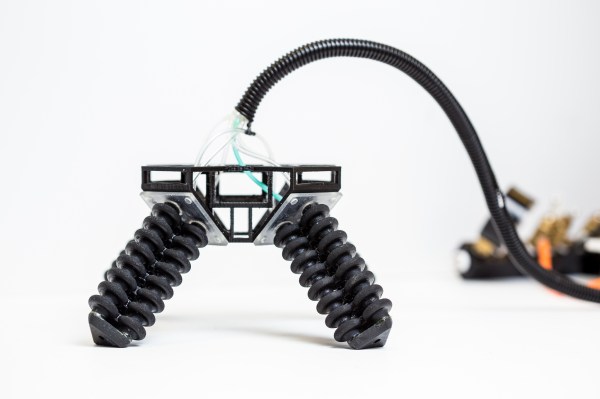A team of engineers at the University of California San Diego have applied the biologically inspired principles of soft robotics in order to develop a robot capable of navigating uneven terrain like rocks and sand.
The soft and pliable materials mean the robot’s four legs are capable of conforming to their surrounds, so its on-board sensors don’t need a precise picture of the ground in traverse it. If the system encounters an uneven spot, it can simply adapt its gait.
The robot’s four legs are a combination of hard and soft printed parts, relying on a bladder-based system of expanding and contracting rubber chambers that propel its movement. It’s a system that’s similar to soft robotics projects, before it, including, a number of machines developed by George Whitesides’ robotics lab in Harvard, which has helped pioneer robots inspired by sea creatures like octopi and squid.
UCSD assistant professor Mike Tolley, who headed up the new research, is a veteran of that Harvard lab, having worked on one of its more notable projects, an untethered X-shaped robot capable of squeezing into tight spaces, thanks to its almost entirely soft body.

“We did demonstrate some walking, but [calling it] ‘walking’ was generous in that it just really shuffled along,” Tolley told TechCrunch during a conversation this week. “It could essentially only move in one direction when actuated. That allowed us to come up with some interested gaits. We did an undulating gait that looked sort of like a worm.”
That research has already led to some interesting real world applications, including the industrial grippers designed by Soft Robotics, whose octopus-inspired hand can pick up a wide variety of shapes and sizes without precise robotic vision. Legs are, of course, a different beast altogether – as is designing a pair that can actually lift up and move around, rather than just sort of undulating their way across a surface.
The team maintained a similar pressure-based air bladder system as the Harvard robot, but added a few pieces to the puzzle to develop a more sophisticated set of legs – along with some harder structural pieces.

“Before, we had these channels that we were inflating to make the legs bend one way,” said Tolley. “But to do what I wanted to do, we would have to make the legs bend around different axes. We couldn’t do it with the simple layered molding techniques we did before. We actually had to come up with a way of repeatably and rapidly making more complex 3D printed bladders.”
The new system features a trio of 3D printed bladders placed side by side. Inflating different combinations that allow for a much fuller control of the robot’s movement. “They’re connected in such a way that when you inflate one, you get bending in one direction,” Tolley added. “If you bend another or do some combination of them, you can actually control a full 360-degrees of bending angles.”
